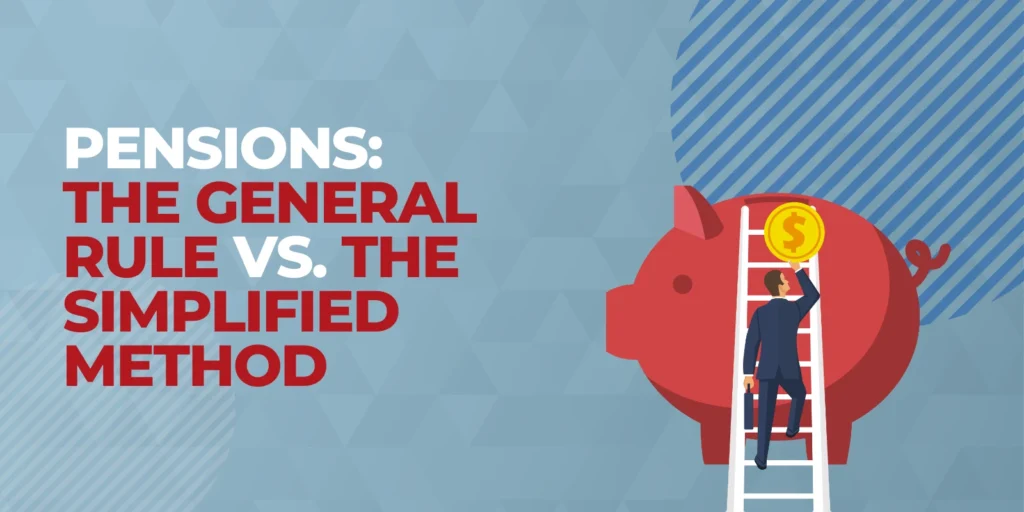
Planning for retirement involves making crucial decisions about your finances, one of which includes understanding how to manage your pension. Pension plans often come with various options and methods for distribution, each with its own set of rules and implications. In this article, we’ll delve into taxable income for retirees. We’ll also compare two common methods for calculating pension and annuity taxable income: the General Rule and the Simplified Method.
Taxes for Retirees
When taxpayers reach retirement, most of their income will likely be from retirement distributions. While some distributions, like those from a Roth account, are not taxable, others are. For example, any contributions that your employer made to your retirement plan, or pre-tax contributions, are taxable. This means you pay taxes when you take the money from your retirement account as a distribution. If some contributions made to your pension or annuity plans were included in your gross income, you can exclude part of the distribution from your retirement income. How much will be determined using one of two methods: the General Rule or the Simplified Method.
The General Rule
The General Rule is a method used to calculate the taxable portion of pension or annuity payments. Under this rule, the taxpayer divides their investment in the contract by the expected return. This is calculated based on the taxpayer’s life expectancy. The resulting quotient represents the tax-free portion of each payment, while the remainder is considered taxable income. Taxpayers can use IRS Publication 939 to calculate the taxed portion of their pension.
Advantages
One of the key advantages of the General Rule is its flexibility. It allows retirees to customize their tax treatment based on their individual circumstances. These include age, life expectancy, and investment in the contract. This method is particularly beneficial for those with longer life expectancies or higher investment amounts. This is because it can result in a larger tax-free portion of their pension payments.
Disadvantages
The General Rule can be complex to calculate and may require assistance from financial advisors or tax professionals. Additionally, it may not always yield the most tax-efficient outcome, especially for retirees with shorter life expectancies or smaller investment amounts.
The Simplified Method
The Simplified Method offers a more straightforward approach to determining the taxable portion of pension or annuity payments. This method involves using a predetermined formula provided by the IRS. The formula considers the taxpayer’s age at the time of the first payment, the total expected return, and the length of the payout period.
Advantages
The Simplified Method is designed to make the tax calculation process easier for retirees by eliminating the need for complex calculations. It provides a standardized formula that applies to most pension plans. This makes it accessible to a broader range of individuals without requiring extensive financial expertise.
Disadvantages
While the Simplified Method offers simplicity and ease of use, it may not always result in the most tax-efficient outcome. This method does not account for individual factors such as life expectancy or investment in the contract, which could lead to a higher taxable portion of pension payments for some retirees.
Limitations
Some taxpayers will be restricted to only using the General Rule. If one of the following scenarios applies to you, you will need to use the General Rule to calculate the taxable portion of your pension.
- Your annuity or pension payments began on or before November 18, 1996
- Your annuity or pension payments began between July 1, 1986, and November 18, 1996, and you do not qualify for the Simplified Method
- Your annuity or pension payments began after November 18, 1996, you were 75 years or older on that date, and your payments were guaranteed for 5 years or more.
- You have received payments from a nonqualified plan
In addition, you must use the Simplified Method if your plan meets all of the following requirements:
- Your annuity or pension payments began after November 18, 1998
- Your annuity or pension payments were from a qualified employee plan or annuity, or a tax-sheltered annuity plan, such as a 403(b) plan
- You must be under 75 years old when the payments begin. If you are 75 or older, your guaranteed payments cannot last 5 or more years.
Comparison
When comparing the General Rule and the Simplified Method, it’s essential for retirees to consider their unique financial circumstances. The General Rule offers flexibility and customization but may require more effort to calculate accurately. In contrast, the Simplified Method provides simplicity and ease of use but may not always optimize tax efficiency.
Ultimately, the choice between these two methods depends on factors such as age, life expectancy, investment amount, and personal preferences. Retirees are encouraged to consult with financial advisors or tax professionals to determine which method aligns best with their individual needs and objectives.
Tax Help for Those with Pensions and Annuities
Managing pension distributions is a critical aspect of retirement planning, and understanding the differences between the General Rule and the Simplified Method is essential for making informed decisions. While both methods offer their own advantages and limitations, retirees must carefully evaluate their options to ensure they maximize their retirement income while minimizing tax liabilities. By seeking guidance from financial experts and considering their unique circumstances, retirees can navigate the complexities of pension distributions with confidence and peace of mind. Optima Tax Relief is the nation’s leading tax resolution firm with over $1 billion in resolved tax liabilities.
If You Need Tax Help, Contact Us Today for a Free Consultation